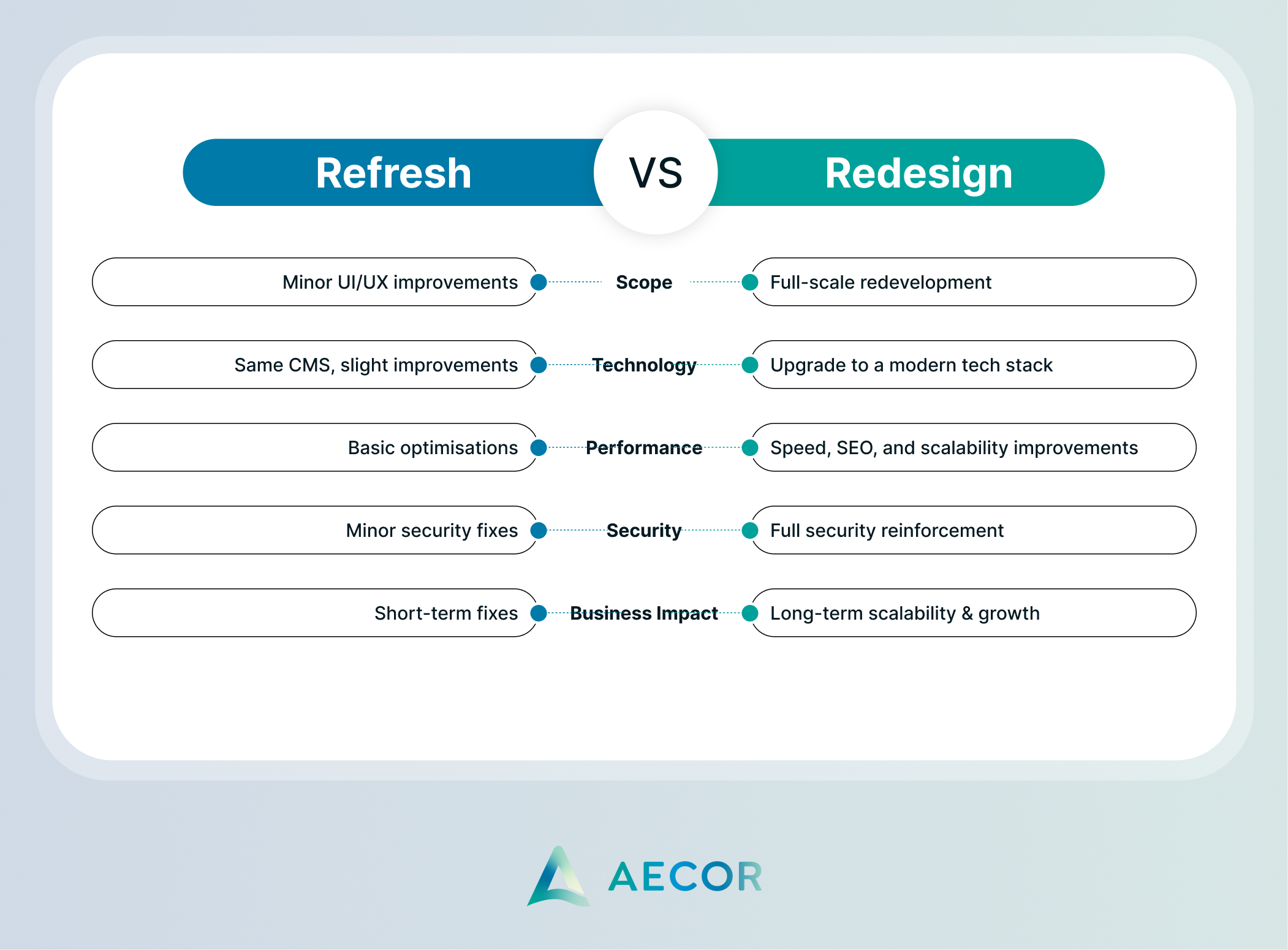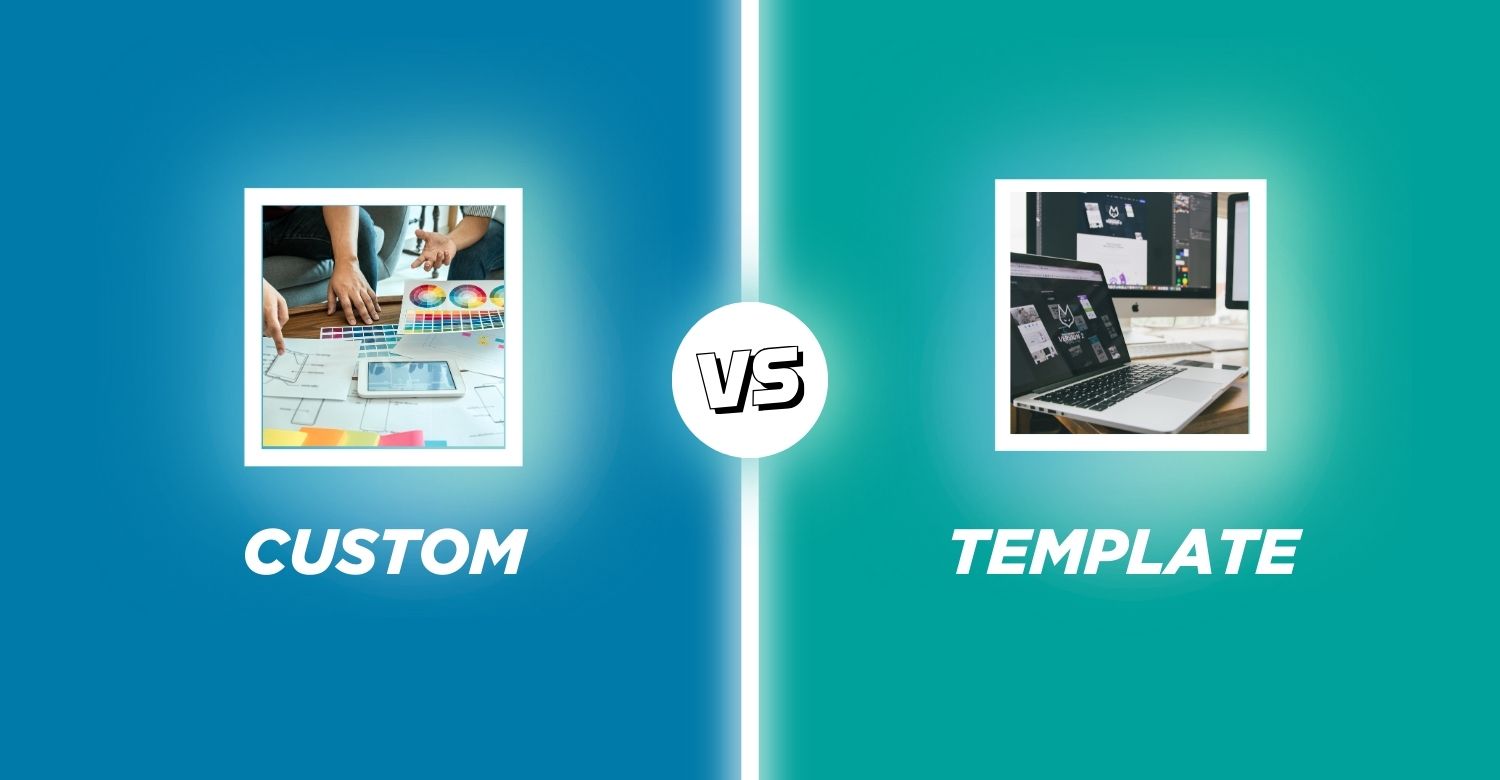5 Signs Your Business Needs a Website Redesign in 2025 – And How to Fix It Fast

A business website is more than just a digital presence—it is a functional asset that drives customer engagement, operational efficiency, and business scalability. However, as technology evolves, many websites struggle to keep up with modern performance, security, and user experience standards.
If your website has not been updated in over two years, it may limit your business growth. Here are five key signs that indicate your website needs an upgrade in 2025.
1. Your website runs on outdated technologies
Is your website still running on older frameworks like PHP 5, outdated WordPress versions, or older JavaScript libraries?
Technology changes rapidly, and outdated tech stacks can introduce security risks, performance issues, and integration limitations.
Common challenges with legacy systems:
- Older PHP, JavaScript, or WordPress versions that are no longer supported.
- Incompatible third-party plugins lead to system instability.
- Limited API integrations, making it harder to connect with modern business tools.
How a redesign helps:
- Migration to frameworks like React.js, Next.js, Laravel, or Django for better performance.
- Implementation of headless CMS solutions (Strapi, Sanity) for flexible content management.
- API-first approach to enable smooth integrations with CRMs, ERPs, and automation tools.
2. Your website is not built for scalability
As businesses grow, websites should be able to scale effortlessly to accommodate increasing traffic, transactions, and evolving customer needs.
Signs your website cannot scale:
- Performance issues when handling high traffic.
- Hardcoded, rigid architecture that makes adding new features challenging.
- Lack of microservices or modular development, restricting flexibility.
How a redesign helps:
- Transition to serverless architecture (AWS Lambda, Firebase, Vercel) for automatic scaling.
- Adoption of modular, microservices-based backends for easier feature expansion.
- Use of cloud-native deployment models for enhanced performance and cost-efficiency.
3. Your website is not optimised for speed & performance
Speed is a key factor for both user experience and SEO rankings. Websites that take too long to load frustrate users and lead to higher bounce rates.
Common performance issues:
- Unoptimised JavaScript and CSS files causing slow load times.
- Outdated database structures lead to longer query times.
- Hosting limitations that result in unexpected downtime.
How a redesign helps:
- Integration of Content Delivery Networks (CDNs) like Cloudflare or AWS CloudFront.
- Optimisation of database queries and caching mechanisms.
- AI-driven performance monitoring to maintain consistent page load speeds.
4. Your website lacks security & compliance standards
With cyber threats increasing, websites must be equipped with robust security and compliance measures.
Security risks of outdated websites:
- No SSL/TLS encryption, making data transmissions vulnerable.
- High exposure to DDoS attacks, malware injections, and SQL injections.
- No GDPR compliance, leading to potential legal risks.
How a redesign helps:
- Implementation of zero-trust security models with OAuth2-based authentication.
- AI-powered threat detection and real-time security patching.
- Compliance with GDPR, HIPAA, and PCI standards for secure transactions.
5. Your content management system (CMS) is inefficient
If your team struggles to update content, manage pages, or automate workflows, your website may need a modern CMS solution.
Challenges of outdated CMS platforms:
- Content updates require developer intervention, slowing down marketing efforts.
- Lack of AI-driven automation makes content management time-consuming.
- Limited flexibility for multi-language support and omnichannel publishing.
How a redesign helps:
- Adoption of headless CMS solutions (Contentful, Strapi, Sanity) for flexible content delivery.
- Integration with AI-powered content generation tools to streamline workflows.
- No-code/low-code editing interfaces, enabling non-technical teams to manage content easily.
Website redesign vs. website refresh: What’s the difference?
Not every website needs a complete overhaul. In some cases, a refresh can be enough to keep your site looking modern and functional. But in other situations, a full redesign is required to upgrade the architecture, security, and performance of the site.
Understanding the difference between these two approaches is key to making the right decision for your business.
What is a website refresh?
A website refresh focuses on improving the visual appeal and usability while keeping the existing structure and backend intact. This is a lightweight update designed to modernise your website without requiring major development changes.
When is a refresh the right choice?
- Your website is technically functional but looks outdated.
- You need to update branding elements like fonts, colours, and UI styling.
- You want to improve user experience (UX) but don’t need a complete rebuild.
- Your site’s core structure and content management system (CMS) still work well.
What a website refresh includes:
- Visual updates – Modernising fonts, colours, and UI elements while keeping the same framework.
- UX enhancements – Adjusting layouts for better navigation and usability.
- Performance tweaks – Minor optimisations to improve speed and responsiveness.
- Mobile adjustments – Ensuring a seamless experience on all screen sizes.
Best for: Businesses with a functional website that only needs design improvements or minor performance tweaks.
What is a website redesign?
A website redesign is a comprehensive transformation of both the front end and back end. This involves rebuilding the structure, upgrading the technology stack, and improving performance, security, and scalability.
When is a redesign necessary?
- Your website is slow, unresponsive, or outdated in both design and functionality.
- Your site has technical issues such as poor scalability, outdated frameworks, or security vulnerabilities.
- You’re struggling with low search rankings due to poor SEO structure and outdated technology.
- You want to migrate to a modern CMS, cloud-based hosting, or a microservices architecture.
- Your business has expanded, and the current website cannot support new features, integrations, or traffic growth.
What a website redesign includes:
- Technology upgrade – Transition to modern frameworks like React.js, Next.js, Laravel, or Django.
- Complete UI/UX overhaul – Creating a new design with a user-first approach.
- Performance optimisation – Faster load speeds, improved caching, and database efficiency.
- Security reinforcement – Implementation of advanced security protocols and compliance updates (e.g., GDPR, HIPAA, PCI-DSS).
- SEO & accessibility enhancements – Optimised for Google’s core web vitals, mobile-first indexing, and WCAG accessibility standards.
- Scalability improvements – Adopting serverless, cloud-based, or microservices architecture to future-proof your website.
Best for: Businesses whose websites are outdated, slow, unscalable, or need a completely new digital presence.
Need a technology-led website redesign? Let’s talk.
At Aecor Digital, we specialise in:
- Software-driven, scalable web solutions for growing businesses.
- Secure, cloud-based deployments for high performance and compliance.
- Custom CMS development for effortless content management.
Free website tech audit – Find out how to optimise your business website for 2025.
What our clients say













